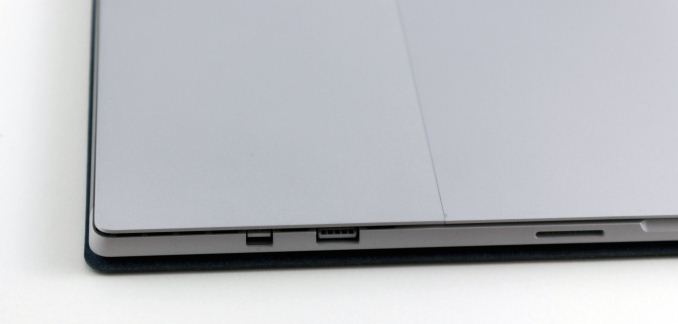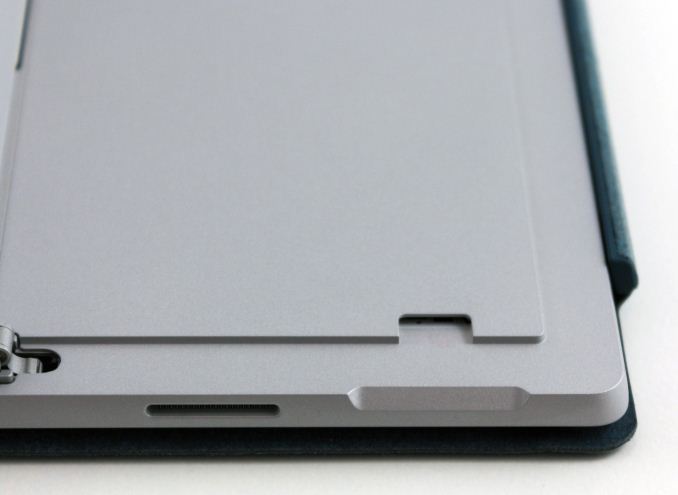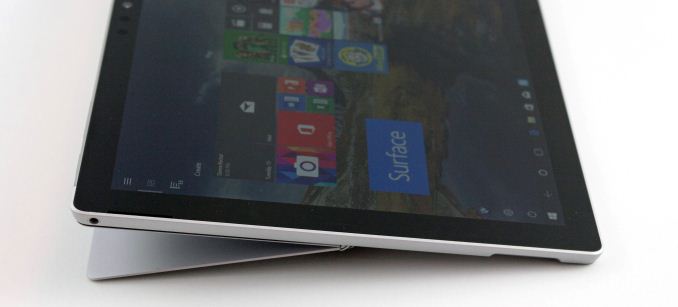The Microsoft Surface Pro (2017) Review: Evolution
by Brett Howse on June 15, 2017 9:00 AM ESTDesign
The Surface Pro 3 brought about a revolution in the design of the Surface Pro family, bringing the 3:2 aspect ratio that is now the signature on all Surface devices, as well as a much thinner and lighter design. Surface Pro 4 evolved that design, bringing a slightly larger display into the same size chassis, while becoming a bit thinner and lighter again. The new Surface Pro continues that evolution-rather-than-revolution philosophy, and that’s arguably the right choice for a successful product.
The latest design has softened the exterior, moving away from the angular design that has been a part of Surface Pro since the beginning. The edges are now slightly rounded, but without radically changing the look. The new rounded sides provide an improved in-hand feel, without the uncomfortable sharpness of the older generations.
The design is familiar though, with the same silver color on the chassis, along with a thin plastic RF window at the top, where the power and volume controls are. The left-side features the 3.5 mm headset jack, the right-side features all of the ports, and the bottom has the keyboard connector.
Speaking of the ports, they are exactly the same as the Surface Pro 4. There’s a USB-A port, a mini DisplayPort, and the Surface Connect for power and expansion. For those that need to add a bit more storage, the new Surface Pro continues to offer a micro SD slot too.
The lack of USB-C with Thunderbolt 3 in a high-end 2017 device is definitely a knock against the new Surface Pro. Microsoft’s reasoning is that USB-C is a port with too many options, and no two ports are guaranteed to be the same, which will lead to customer confusion. There’s also the argument that most of our devices still use full-sized USB, so Microsoft has stuck to its guns and just kept the USB-A port. They aren’t wrong about USB-C being confusing, though. Other than USB data, which is the one thing that all USB-C should support – although not always at the same speed – ports can support displays, higher power levels, Thunderbolt 3, and more. The counterpoint to this argument is that Surface Pro could offer a USB-C that features everything, although it would cost not only in terms of actual cost, but also space for extra chips, and in a small device like the Surface Pro, space is at a premium.
Their other argument is that, at least currently, almost anything that connects to USB-C needs an adapter or dongle of some sort, and that’s also true. But the counter to that is that the Surface Pro features a mini DisplayPort, which arguably needs a dongle or special cable to connect to almost anything anyway. A USB-C could offer the same DisplayPort signal, but way more.
There’s no argument that keeping the USB-A port is the right idea for today, but it would have been nice to see Microsoft adopt the new standard for the future, since a device with this kind of price has to have the expectation that it will still be around in several years, when USB-C will be more widespread.
The Kickstand
The one area that Microsoft both pioneered – and continued to evolve – is the kickstand. Looking back at the original Surface devices, the kickstand really the key to the entire device, allowing Surface to quickly and easily be used as both a tablet, and a laptop. The latest kickstand improves everything, again.
The biggest change is that the kickstand now opens even wider. The opening arc increases from 150° to 165°, which gives the Surface Pro an even better platform for using the Surface Pen, and accessories like the Surface Dial, which works right on the display, just like the Surface Studio.
The new kickstand seems to be even smoother than the Pro 4, and still offers just the right amount of friction to not allow the Pro to change angles when using touch on the display.
The kickstand is still one of the signature features of the Surface Pro, and it’s great to see it continue to improve.
Cooling Upgrades
The Surface Pro 4’s cooling was a big improvement over the Surface Pro 3, greatly reducing CPU thermal throttling, but also being quieter. The new Surface Pro develops on this again. When the Surface Pro 4 launched, the engineers let us know that they felt that the cooling system could dissipate the full 15-Watts of heat from the CPU passively, but they still included the fan on both the Core i5 and Core i7 models for the Surface Pro 4.
The new Surface Pro ditches the fan completely on the (15W) Core i5 model now, leaving just the (15W) Core i7 model with active cooling. Microsoft hasn't yet sampled this model of the Surface Pro, but hopefully we’ll be able to test it out soon to see what ramifications that changes has for performance. For noise though, it’s all good news, since it should be practically silent.
The Core i7 model, that we do have for review, is even quieter than the outgoing Pro 4, especially when at its default settings. So despite the active fan, the cooling system is much quieter. The cooling vents have been changed as well, with a much more subtle look to them on the new Pro.
The cooling changes have all been positive, and we’ll check out the performance of them later in the review.













124 Comments
View All Comments
skavi - Thursday, June 15, 2017 - link
They have a coating on the fabric to prevent the worst of wear. If you've touched it, it feels a bit more rubbery than expected based on appearance.BrokenCrayons - Thursday, June 15, 2017 - link
Since the keyboards are easily detached and can be replaced independently of the rest of the tablet, wear and tear might not be a problem as long as you can get your hands on a new one after it starts looking ragged. I know that's not an ideal solution, but it shouldn't discourage purchase of one of these things for those people that still have an interest in buying a tablet in modern times.BillBear - Thursday, June 15, 2017 - link
For $130 apiece, you think they are disposable?fanofanand - Thursday, June 15, 2017 - link
It is an odd position for BrokenCrayons to make, as he is typically a proponent of less waste and spending less on tech. To each their own but this seems to be very inconsistent with his previous posts. I think $2600 is absurd for what you get.BrokenCrayons - Friday, June 16, 2017 - link
My justification is based on the purchase price of the Surface Pro. The price is fairly high relative to the hardware specs and suffers from limits in utility due to its tablet form factor. For someone making that sort of purchase for personal use, I'll go out on a limb to argue that there are emotional and social implications (ex: desire for a status symbol, brand loyalty to Microsoft, etc.) that override practical considerations and therefore the cost of a replacement keyboard is probably a less significant factor than the need to have one that looks fresh and new. In short, this is about the psychology of the buyer which doesn't have a lot to do with my personal preference to use borderline derelict laptops for my own computing needs.Eliadbu - Friday, June 16, 2017 - link
Just buy Eve-V why pay excessive amount of money for a brand.simard57 - Wednesday, June 21, 2017 - link
has the Eve-V been reviewed here at AT?simard57 - Wednesday, June 21, 2017 - link
if HP, Dell or Lenovo offered a 3:2 display - I would seriously consider it.I would lean towards the 360 models. I wonder why Microsoft didn't make the Surface Laptop a 360 model 2-1. are there serious compromises required to support a 360 hinge over a traditional clam shell laptop?
desolation0 - Thursday, June 15, 2017 - link
The $130 version does not include the Alcantara fabric, but also seems to stick with basic black for color scheme. It is not available yet, but is listed on the Microsoft Store. The Alcantara sheathed signature edition cost $160. If you are more worried about durability and a bit of savings than feel and style the regular edition would be your cover of choice. On the subject of durability and replaceability, it should be noted that the keyboard parts for most ultrabooks and laptops are available significantly cheaper. Unfortunately, for many ultrabooks and some laptops the replacement process can be prohibitively difficult for the average consumer. Professional repair service can run you as much or more if you don't shop around successfully.name99 - Thursday, June 15, 2017 - link
Why the insistence on these sorts of very thin "cover" keyboards? Seems like painting yourself into a corner.For iPad you can use a separate bluetooth keyboard (eg the same Apple wireless keyboard that you can use with an iMac) and just carry that with you, along with a very lightweight cover that also acts as a stand (like the Apple cover and a thousand other covers). I assume Surface can also use a BT keyboard.
This pair doesn't look like a laptop anymore, if anything it's more like using an iMac. But it does mean you don't have to force all the compromises and constant weight of a super thin keyboard. It also means that (depending on your exact usage patterns) you can leave the keyboard at home, or in your hotel room, or whatever, and use the on-screen keyboard for small messages, just switching to the real keyboard when you need to type a lot.
Seems to me a better alternative for most users --- but most people seem unaware of it. Even in the Apple store, they were clueless when I explained this to them --- I had to actually demo pairing an Apple keyboard with an iPad before they believed me!
People are just locked into this mental image of "make it look+feel like a laptop" even though that's not necessary.